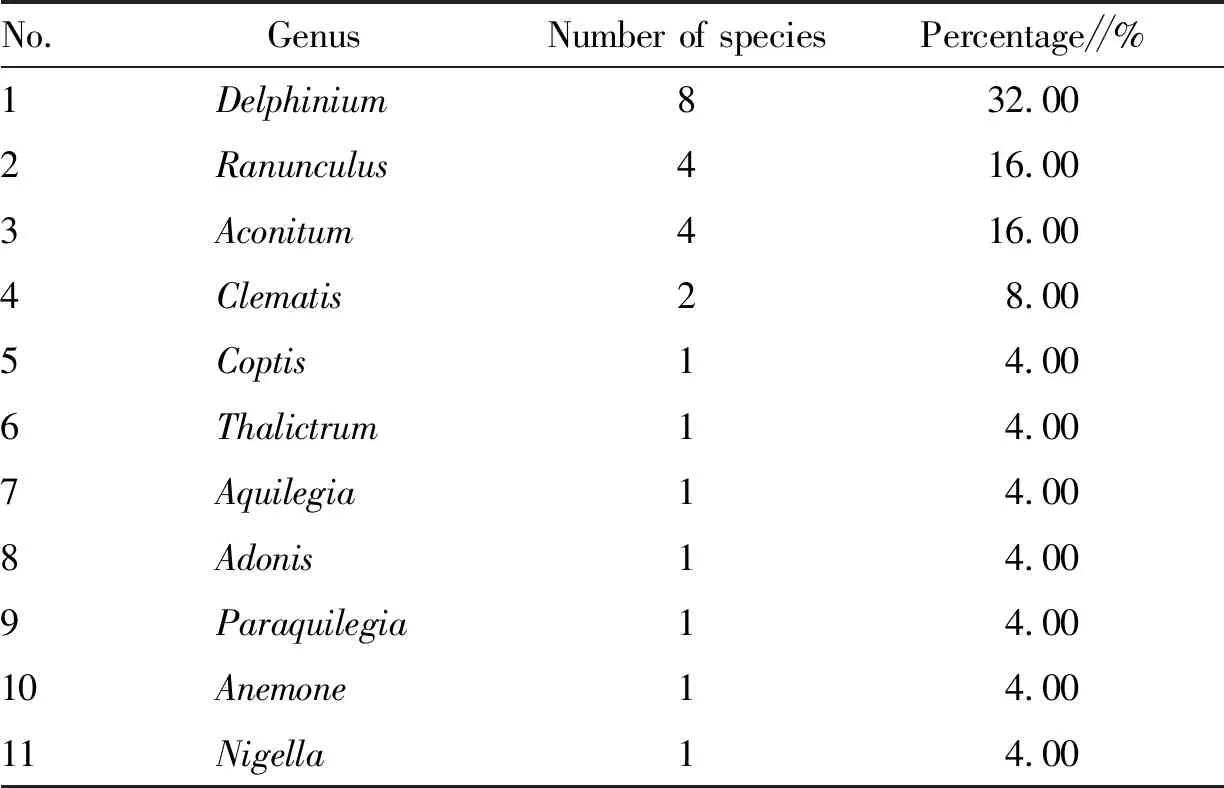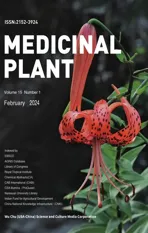A Brief Analysis of Ranunculaceae Family Resources Based on Yu Tuo Ben Cao
2024-03-07HongyeYINNamucuoLongzhuduojie
Hongye YIN, Namucuo, Longzhuduojie*
1. School of Life Sciences, Qinghai Normal University, Xining 810008, China; 2.School of Computer, Qinghai Normal University, Xining 810008, China
Abstract [Objectives] To facilitate the rational use and timely protection of the Tibetan medicinal plant resources to count and reorganize Tibetan medicines recorded in Yu Tuo Ben Cao. [Methods] Based on literature research and data analysis, this paper analyzed the plant genera, and their habitat characteristics and the main types of diseases. [Results] Yu Tuo Ben Cao contains 191 kinds of botanicals, of which Ranunculaceae has the largest number of 11 genera and 25 species, with a wide distribution of habitats and 5 categories, and the main therapeutic efficacy covers 16 fields. [Conclusions] As a part of Yu Tuo Ben Cao, Tibetan medicines of Ranunculaceae have great research value because of their variety, large number, wide distribution, and diverse uses.
Key words Yu Tuo Ben Cao, Plant resources, Ranunculaceae
1 Introduction
Since the introduction of theOutlineoftheStrategicPlanfortheDevelopmentofTraditionalChineseMedicine(2016-2030) and theLawonTraditionalChineseMedicine, the development of Tibetan medicine has been highly emphasized. All levels of government in China have been actively carrying out work to promote the development of Tibetan medicine and cultivate talents in Tibetan medicine[1]. Most of the traditional Tibetan medicines are derived from wild plants, and after a long period of abusive exploitation, the situation of some wild plant resources of Tibetan medicines is extremely serious[2], which should be studied and protected in a timely manner. There are thousands of Tibetan medicinal plants, which are included in various kinds of literature.YuTuoBenCaowas written in the middle of the 8thcentury AD, by the ancestor of Tibetan medicine, Qianyutuo Yundan Gunpo. It is the earliest classic Tibetan medical herb work. It is known as theThreeGreatMateriaMedica, together with theDuMuBenCaoand theMiaoYinBenCao, and was later translated by Mr. Mao Jizu for the general scholars to read. A total of 191 medicines were recorded in the book, and each of which was accompanied by color pictures. Information on the habitats, morphology, and main therapeutic effects of the medicines was recorded onYuTuoBenCao[3].
In this paper, we applied the method of literature collation and data analysis to statistically organize the Ranunculaceae of Tibetan medicines recorded in theYuTuoBenCao, analyzed and explored their varieties, habitat characteristics and types of main diseases, so as to provide a certain basis for the protection and rational development and utilization of the botanical resources of Ranunculaceae of Tibetan medicines with a view to contributing to the further development of Tibetan medicine.
2 Information and methods
2.1 Data sourcesThe data in the text are selected from theYuTuoBenCao, published by Qinghai People’s Publishing House in 2016. All Tibetan medicinal plants recorded in the book were entered into a structured Excel table using the six fields of the name of Tibetan medicines, family, genus, species, habitat, and main treatment diseases as keywords, repeated calibration for accuracy. Entry principles: Firstly, the name of the species of Tibetan medicine is based on the original name in the book; Secondly, the family, genus and species classification of Tibetan medicines were queried fromFloraofChina; Thirdly, the Ranunculaceae plants’ habitat and its main therapeutic effects are based on the original text, extensive reading of theDuMuBenCao,MiaoYinBenCao,TibetanMedicineJingJingMateriaMedica,etc.and related thesis data as a supplement to the integration of the information will be perfected.
2.2 Data analysisWe made a statistical and proportional analysis of the classification, habitats, and therapeutic efficacy of Tibetan medicinal plants of the inYuTuoBenCao[4]. Further, we summarized the characteristics of traditional Ranunculaceae Tibetan medicine resources based on the data after statistical analysis.
3 Results and analysis
3.1 Statistical analysis of generaAccording to the analysis of the family structure of plants in theYuTuoBenCao, the five types of families that accounted for the largest number of plants were, in order, the Ranunculaceae family, the Compositae family, the Cruciferae family, the Leguminosae family, and the Papaveraceae family. Among them, the Ranunculaceae family of plants accounted for the first place in Tibetan medicine, a total of 11 genera and 25 species. There are some common genera, such asDelphinium,Ranunculus,Clematisand so on. Next is the Compositae family, a total of 12 genera and 21 species. Some common genera are as follows:Saussurea,Taraxacum,Asteretc.The distribution of family species is shown in Table 1.

Table 1 Distribution of more than 3 species in the family, genus and species of Tibetan medicines
3.2 Analysis of Tibetan medicinal resources in the RanunculaceaeThe Compositae, as the largest family of seed plants in the world and also in China, is found all over the world except in the Antarctic and Arctic regions[5]. In most of the botanical medicine classics, statistically analyzed by different scholars, the Compositae also tends to be ranked first in terms of quantity, such asJingzhuMateriaMedica[6],JingjingMateriaMedicaofTibetanMedicine[7], andYuewangYakangMateriaMedica[8].YuTuoBenCaointroduced the Ranunculaceae of Tibetan medicine in the number of species over the Compositae of Tibetan medicine for the first time. Based on this, we made a further statistical analysis of the Ranunculaceae of Tibetan medicine.
3.2.1Tibetan medicines in the Ranunculaceae. From the Ranunculaceae family species structure analysis, the book records a total of 11 genera in the Ranunculaceae family, the main genera for theDelphinium, a total of 8 species, accounting for the total species ratio of 32.00%; this was followed byRanunculusandAconitumwith 4 species each, accounting for 16% of the total species ratio, as shown in Table 2.

Table 2 Statistics of Tibetan medicines in the Ranunculaceae family
3.2.2The habitat of Tibetan medicines in the Ranunculaceae. Habitat statistics of Tibetan medicines in the Ranunculaceae family recorded in the book, it can be concluded that the Ranunculaceae family of Tibetan medicines have a total of five kinds of major types of habitats: rocky mountain and cliff (rocky mountain, cliff, barren land); shady slope; embankment or foothpath between paddy fields; forested wetland (forests, beside canals, swamps); drylands. Among them, the largest number of Ranunculaceae family Tibetan medicines grows at the rocky mountain and cliff, totaling seven genera and nine species, followed by embankment or foothpath between paddy fields, totaling six genera and six species, as shown in Table 3. According to the book, some of the plants have multiple habitats, such asCoptischinensis, which grows in two places, the ridge and the soil cliff.

Table 3 The habitat of Tibetan medicines in the Ranunculaceae
3.2.3The main therapeutic efficacy of Tibetan medicines in the Ranunculaceae. The Ranunculaceae family of Tibetan medicines covers 16 areas of therapeutic efficacy. The Tibetan medicine for treating plague diseases, insect diseases and other infectious diseases is the most, a total of 11 species of 5 families, and they focus onAconitumandDelphinium, such asAconitumpolyanthumvar.puberulum,Aconitumszechenyianumand so on. The second is to dispel cold, a total of 3 genera, 5 species, such asRanunculustanguticus,Anemonecathayensis, as shown in Table 4.

Table 4 The main therapeutic efficacy of Tibetan medicines in the Ranunculaceae
4 Discussion and conclusions
As the earliest classic herbal medicine of Tibetan medicine,YuTuoBenCaois rich, accurate, easy to understand and of high research value, so it is a rare classic illustrated book of Tibetan medicine. This paper presents a detailed and accurate statistical analysis of the family, genus and species classification of Tibetan medicinal plants recorded inYuTuoBenCao, the genus and species classification of the Ranunculaceae, as well as the habitats and main therapeutic effects of the Ranunculaceae. We reached the following conclusions: there are 191 species of botanicals in the book, involving 54 families and 127 genera; among them, there are 25 species of 11 genera in the Ranunculaceae family, and the habitats to which they belong are summarized into five categories, and these botanicals can be used for the treatment of 16 kinds of diseases. The analysis of the habitats and therapeutic efficacy of traditional Tibetan medicines of Ranunculaceae can provide a certain reference for their protection and rational development and utilization.
There is a unique ecological environment that breeds a large number of organisms that are different from those at lower elevations in the Tibetan Plateau, with an average elevation of more than 4 000 m above sea level[9], and there is no shortage of traditional Tibetan medicinal plants. Nearly half of the Ranunculaceae family of Tibetan medicines recorded in theYuTuoBenCaogrows at high altitude among the rocky mountain and cliff. Early Tibetan herbal medicine existed in the form of "medicine and food", and later, in the continuous exchanges and integration with neighboring ethnic groups, Tibetan herbal medicine was gradually perfected[10]. Therefore a large number of Tibetan medicines are also present in fields, slopes and other populated areas. In recent years, people’s demand for Tibetan medicines has been increasing, and the market demand exceeds supply. Some of the Tibetan medicines are already endangered species, and the technology of planting a large number of Tibetan medicines has come into being[11], in order to help the protection and development of Tibetan medicines, the growth environment of Tibetan medicines of Ranunculaceae family should be fully analyzed.
Tibetan medicine is the basic tool of Tibetan medicine to solve all kinds of diseases. There are thousands of different types of medicines for the treatment of various kinds of miscellaneous diseases in daily life[12]. The Ranunculaceae family of Tibetan medicines recorded in theYuTuoBenCaocan treat 16 types of diseases, covering a wide range of areas such as infectious diseases, digestion, kidneys, detoxification,etc., and is the essence of the medicines used by clinical Tibetan doctors at that time. Tibetan medicine has been developed for thousands of years, and some of the drug uses may have been forgotten. Statistical analysis for the main therapeutic efficacy of the traditional Ranunculaceae family of drugs in theYuTuoBenCaocan provide a powerful reference for the rational development and utilization of Ranunculaceae family of Tibetan medicines.
TheYuTuoBenCao, as a summary of early Tibetan medicinal plants, has an irreplaceable position in the history of the development of Tibetan medicine. With the integration of traditional Chinese medicine and ethnic medicine with the new era, the statistical analysis of Tibetan medicines included inYuTuoBenCaoand the organization of the traditional Ranunculaceae family of Tibetan medicines with their habitat characteristics and therapeutic efficacy, which are given to the relevant scholars for reference, can be conducive to the long term development of Tibetan medicine.
杂志排行
Medicinal Plant的其它文章
- Effects of Exogenous Plant Hormones on Growth Status and Secondary Metabolism of Houttuynia cordata Thunb.
- Identification of Xunxi Shujin Decoction by TLC
- Preparation of 20 (S)-protopanaxadiol PLGA Nanoparticles
- A Network Pharmacology Study on Active Components and Targets of Citri Reticulatae Pericarpium for Treating Keloids
- Pharmacognostic Identification of Hedyotis auricularia and Mitracarpus villosus
- Determination of Salvianolic Acid B in Yiqi Huayu Prescription by HPLC
